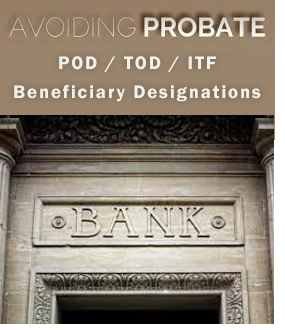
Over the past year, an increasing number of clients have asked me about transfer-on-death (TOD) designations and how they can play in to their estate plan.
TOD designations are quite common in the financial industry. They operate very similarly to a beneficiary designation on life insurance or a retirement account.
You complete the TOD designation and when you pass away, the account funds are transferred to the person you designated. At some banks, you may find them called POD (pay on death) or ITF (in trust for) accounts. Despite their name, ITF accounts are Not trusts (more on that in a moment). At many credit unions I see them called beneficiary designations. To be clear, TOD, ITF and beneficiary designations are not the same thing from a legal standpoint, but they operate the same way when someone passes away.
Most of our clients and their advisors are familiar with how beneficiary designations work. Assets subject to beneficiary designations are paid to the designated person upon passing without going through the probate process. Because avoiding probate is an important goal for many families, I regularly am asked the following questions:
“Why can’t I just designate the people I want to receive my assets upon my demise? Why do I need to spend the time and money to put a trust in place and make sure my assets are coordinated with the trust?”
Indeed, these are very valid questions!
As indicated above, even if specific accounts are designated as ITF for a beneficiary, such accounts are NOT a trust? That’s true for all of the acronyms – ITF, TOD and POD. And it is the reason why most experienced estate planning attorneys do not consider TOD designations to be “real” estate planning. That is because “real” estate planning will take care of all the contingencies you can think of in the event of your passing.
For instance, most TOD designations allow you to designate one person, or class of people (e.g., children), as beneficiary. You cannot name a backup or contingent beneficiary. If the person you name is not living when you pass away, the account goes through the probate process. And if the person you have designated as beneficiary lacks legal capacity when you pass away, a Guardianship proceeding may very well need to be raised in order to have a Conservator established for your beneficiary through the local probate court – that costs time and money and is often a protracted public proceeding!
A Trust, on the other hand, allows you to cover all the contingencies you can think of, and likely some that you may not think of. Among other things, you can state under the terms of your Trust exactly how you want your property to be distributed if one or more of your designated beneficiaries is not living when a distribution is made. And if someone lacks legal capacity, you can have his/her portion held in trust for his/her benefit, removing the necessity of a Guardianship proceeding in order to appointment a Conservator.
Please note that a TOD designation and a Trust do not need to be mutually exclusive. We regularly use them together to increase convenience for clients during life and distribution in the event of their passing. For example, we regularly work with clients to have one or more of their bank accounts distributed under a TOD designation to their Trust.
We hope that this edition of Estate Planning Matters helps clarify some of the financial account acronyms we often use in estate planning.
As a trusted advisor, we have a fiduciary duty and moral obligation to our clients to help them avoid negative consequences of bad planning. That duty includes keeping up-to-date on practical and legal issues related to estate planning, as well as getting your clients the help they need, when they need it, to ensure that their estate plan is in accordance with their goals and objectives.
Being able to spot common estate planning problems can do a lot for your business. It can expand your relationships with clients and allow you to serve them in a fuller capacity – one that’s more intrinsically rewarding and profitable for you.
Currently, you probably have more than enough on your plate now. Therefore, the thought of getting into estate planning and probate law may be overwhelming. Subjects such as planning to avoid probate, developing workarounds for clients to reduce taxes, and examining financial instruments to recommend for various situations can make your head spin.
Fortunately, you do not need a law degree or years of study, to spot some very common gaps in your clients’ estate plans!
Below we have set out eight (8) strategies to determine your clients’ estate planning risks. Like gauges on your car’s dashboard, when you see these signs “light up,” it might be time to bring an experienced estate planning attorney into the mix to figure out what’s happening and what needs to be done to clean things up.
8 Easy to Spot Estate Planning Issues – Signs You and Your Client May Need to Call in an experienced estate planning attorney.
Set aside some time and pull out your client list to review account titles, legal documents, and look for the following blatant signs that an estate plan might fail:
1. A Will-Based Estate Plan, or No Estate Plan
Wills can be good estate planning tools, when used correctly. But in many cases, they are not used peoperly! A proper estate plan often includes the goal of avoiding probate, along with costs, delays, and publicity of a probate proceeding.
If your client dies intestate, that will reflect poorly upon all of his or her financial, legal, and tax advisors, and possibly lead to lots of headaches for both beneficiaries and advisors in your future.
Many Wills we review are very often not drafted properly. For example, if the terms of the Will attempt to include property held in joint tenancy or if the Will designates a beneficiary that conflicts with other beneficiaries named on other legal documents, your client’s goals are not adequately expressed. They might even be setting up their heirs for a long and expensive probate court proceeding. Don’t let that happen. Step in, take command and the initiative to get problems solved while your clients are competent and alive, before the proverbial ship has sailed.
2. An Unfunded Revocable Living Trust
Unfunded trusts can lead to as many problems as a poorly written Will. Some assets will require more time and attention to handle properly during the estate planning process. These include real estate, intellectual property, certain types of stock, business partnerships, and promissory notes. However, building a solid foundation through proper funding, is very important if the plan is to work as intended when it’s needed.
3. Exposed Assets
Assets held as joint property can pose problems if the surviving spouse has a lot of debt. Protect your client’s by ensuring their assets are titled correctly and insured properly. Otherwise, the estate settlement could be held up in court, as debtors seek to get their claws on those assets. Again, if you spot a red flag, bring it up with your client, so you can both start to address it.
4. Assets Distributed Outright to Beneficiaries
An estate plan that provides for outright distributions to beneficiaries leaves that inheritance unprotected from creditors, predators, divorcing spouses, and lawsuits, and lack of investment experience….as well as an inheritor’s own bad decisions. There is a better way. An experienced estate planning lawyer can help your clients by reviewing and analyzing current legal documents in force, along with relevant planning strategies to find the perfect match in order to solve problems for your clients.
5. Family Members as Successor Trustees
One problem with naming family members as successor trustees is that many people name two or more co-trustees. If the family members do not get along; if they don’t trust each other; or if they disagree with each other’s decisions, they could end up fighting about it in court.
In that case, all the inheritors will be waiting for their inheritance, possibly for years. This can be avoided by naming an institution, such as a bank or trust company, as the primary trustee and the family members as co-trustees. The primary trustee can mediate disagreements that arise, saving the family time and money in the process. In our experience, family strife is often a significant cause of estate planning failure after the client dies.
6. Outdated Beneficiary Designations
Even if your clients or prospects have recently updated their estate plan, one common oversight is revising beneficiary designations for their annuities, 401(k)s, IRAs, or life insurance to coordinate with the new plan. It is also possible that a beneficiary designation has not been changed since the account was initially opened, but the client’s circumstances have drastically changed, due to marriage, a divorce, or death in the family. Therefore, it is vitally important to check and update the beneficiary designations for accounts you know have been around for a long time – because chances are, there are some Beneficiary Designation Forms that need updating.
7. Too Much or Not Enough Life Insurance
The federal estate tax exemption continues to increase each year, which is approaching nearly $5.5 million per person. Therefore, many older people might now be over insured. Policies with high cash values can be tapped to provide cash flow or terminated in favor of becoming other investments, adding assets to your management or providing you with an opportunity for the placement of more appropriate financial products. Alternatively, many younger clients and prospects may be under-insured, leaving their loved ones vulnerable to lost wages and unmanageable debt.
8. Lack of Long-Term Care Planning
While many people plan for what happens after they die, a surprising number fail to plan for extended illness or deteriorating mental capacity. Emphasize to your clients that they need some form of Long-Term Care Plan arrangement, and that such a plan needs to be funded somehow.
Key Takeaways:
By identifying common gaps in your clients’ estate plans, you can be of much greater service to them and protect them from undesireable outcomes they may not even see coming.
Fortunately, you do not need to do a deep dive into estate planning law to spot the glaring red flags that I’ve shared with you in this issue. Spotting these red flags can serve as a springboard for you, leading to deeper conversations with clients about their future and possibly bringing you more business with them.
Call Us, We’re Here to Help:
Don’t worry about actually fixing all of the problems you uncover – that’s where we can help. Call us, and we’ll answer your questions, review client documents, and explain the available options to avoid the pitfalls.
We would also be happy to strategize with you to establish a process for identifying the most promising areas to help your clients establish appropriate estate plans, as well as generate new business,for your firm.
Distributions from an inherited Individual Retirement Account (IRA) generally are taxable in the year the distributions occurs. However, Internal Revenue Code Section 402(c) provides for an exception: Distributions rolled-over to a separate retirement plan account established for the beneficiary. There is a caveat to this exception, which was recently highlighted in Letter No. 2016-0062 from the Internal Revenue Service.
IRS Letter No. 2016-0062 pertains to an attempted roll-over implemented by a surviving son from his deceased father’s retirement account. The decedent’s accounts were from employee retirement plans, to be paid to a non-spouse. Under IRS Code 402(c)(11), retirement plan account distributions for deceased employees, that are transferred to a retirement account established for a non-spouse beneficiary, may be eligible for the income tax-free rollover. However, the IRS noted that the accounts in question in that case were not rolled-over into another retirement account established for the son’s benefit, but rather were paid directly to the son, and thus did not qualify for the Section 402(c)(11) rollover exception. This was a serious and irreversible error since IRS rules and regulations do not provide a “60-day Put-Back Rule” for payments made directly to non-spouse beneficiaries of tax-deferred retirement plan accounts.
Individuals who are interested in the long-term growth and preservation of their retirement plan assets, which distribute to loved ones upon their passing often implement a Retirement Plan Inheritance Trust, which is also known as an IRA Beneficiary Trust. These trusts may be especially useful for you and your clients in order to protect tax-deferred assets from the potential claims of the surviving spouse and children from creditors claims, including loss of property in the event that a child’s marriage dissolves, as well as from other creditor issues which often arise throughout the lives of children.
 Anne Denny’s book My Voice, My Choice: A Practical Guide to Writing a Meaningful Healthcare Directive is written as a guidebook that addresses the medical, emotional, legal, social, financial, and spiritual dimensions of preparing for end-of-life health and personal care decisions.
Anne Denny’s book My Voice, My Choice: A Practical Guide to Writing a Meaningful Healthcare Directive is written as a guidebook that addresses the medical, emotional, legal, social, financial, and spiritual dimensions of preparing for end-of-life health and personal care decisions.
Please let us know if you, or your selected clients would be interested in receiving this guidebook.
Please also feel free to call Suzanne or Margo at The Levin Law Firm to arrange a consultation with trust and estate planning attorney Philip Levin, Esq., at (610) 977-2443.
Phil would be pleased to discuss strategies for starting conversations with your clients about estate planning, issues surrounding Life-Care Planning solutions, along with how to properly establish and implement appropriate wealth transfer plans for your clients.
If you or your selected clients are interested in reading some Testimonials from valued clients of The Levin Law Firm, click here: https://levinlawyer.com/home/testimonials/
 The loss of a spouse is a devastating event that has long-term repercussions, both emotional and financial. A surviving spouse is often required to provide immediate attention to matters related to the estate administration (much of which might be unfamiliar to them) even as they process and adjust to their loss and grief.
The loss of a spouse is a devastating event that has long-term repercussions, both emotional and financial. A surviving spouse is often required to provide immediate attention to matters related to the estate administration (much of which might be unfamiliar to them) even as they process and adjust to their loss and grief.
Very often, the surviving spouse is appointed as the estate administrator but may not be able to concentrate on the probate process, resulting in missing relevant court filings and tax payment deadlines. If the decedent had named their spouse, a child, or another person as executor, the individual selected to administer the estate may decide to retain an attorney to assist with many of the estate administration functions. If the decedent died without a Will naming an executor, state law generally provides that an individual can petition the court to take on the role of personal representative, or the court will appoint an individual to take charge of the estate settlement.
When an individual dies, the surviving spouse should address at least the following three (3) estate administration items in the first few weeks or month following the death:
- Legal Documents. Whether the surviving spouse will serve as personal representative, or someone else will serve in that role, the survivor can help to organize and expedite the estate settlement process by gathering and organizing the deeds to all real estate owned in the individual name alone and in joint ownership with a third-party, securing current retirement plan account statements, marriage certificate, life insurance policies, the Last Will and Testament, Trust Agreements, and at least two (2) original death certificates. The executor or personal representative, which may or may not be the surviving spouse, will need to review these items to determine the proper procedure for administering the estate and any trust which was established by the decedent during their lifetime.Depending on how beneficiary designations were completed, retirement plan assets and life insurance death benefits may be subject to probate. However, if the decedent’s beneficiary designations for tax-deferred retirement plans and life insurance have individuals or charities designated as the beneficiary, then these type of assets should not be exposed to the probate process, which assets often distribute either outright, or in trust, to the surviving spouse and any children.
- Review Benefits Payable to the Surviving Spousal. Life, health, and liability insurance policies should be properly reviewed. The decedent’s employer may have additional details about potential benefits a surviving spouse is entitled to receive. If the surviving spouse had been designated as primary beneficiary of retirement accounts, he or she typically will have the option to implement a spousal rollover.
- Elections for Portability and Elective Share. If available, the surviving spouse might desire to opt for portability of the deceased spouse’s unused estate tax exemption amount by having an experienced accountant prepare and file a federal estate tax return. Portability allows a surviving spouse to use the unused portion of their deceased spouse’s federal estate tax exemption, which, under current law, could allow a surviving spouse to leave almost $11 million in assets to their beneficiaries free of federal estate tax. However, the estate executor must make the election in a timely manner by filing a federal estate tax return for the deceased spouse within nine (9) months following the first spouse’s death.
If you or your clients would like to learn more information about estate planning and settlement matters, please call The Levin Law Firm at (610) 977-2443 to arrange a consultation with trust and estate planning attorney Philip Levin, Esq.
Please visit our home page to learn more about the estate planning services provided by The Levin Law Firm. To read testimonials from some of our valued clients at The Levin Law Firm, please click here: https://levinlawyer.com/home/testimonials/

